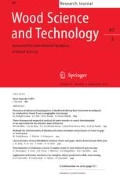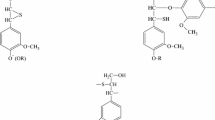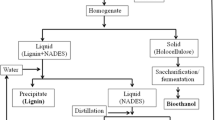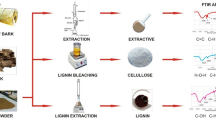Abstract
Chemical changes in cell wall components of bamboo internode during steam explosion process were analyzed to investigate self-binding mechanism of binderless board from steam-exploded pulp. More than 30% of xylose on initial mass, which is a major hydrolyzate of bamboo hemicelluloses, was lost after steam explosion treatment. Bamboo lignin is characterized by the presence of ester- and/or ether-linked p-coumaric acid to lignin. The content of phenolic hydroxyl groups of lignin isolated from steam-exploded pulp was characterized 2.3 times higher than those of the extract-free bamboo internode due to the cleavage of β-O-4 linkages. Alkaline nitrobenzene oxidation of the bamboo lignin gave vanillin, syringaldehyde and p-hydroxybenzaldehyde as major products. The content of p-hydroxybenzaldehyde decreased after steam explosion treatment, indicating the cleavage of ester- and/or ether-linked p-coumaric acid. The total yield of erythronic and threonic acids in ozonation products of the extract-free bamboo internode lignin was 268 mmol (200 g lignin)−1, while those of lignins in the steam-exploded pulp and powdery fraction were 96 and 129 mmol (200 g lignin)−1, respectively, suggesting the significant cleavage of β-O-4 linkages during steam explosion treatment. The cleavage of β-O-4 linkages was also confirmed by 1H- and 13C-NMR spectroscopic observations.



Similar content being viewed by others
References
Akiyama T, Sugimoto T, Matsumoto Y, Meshitsuka G (2002) Erythro/threo ratio of β-O-4 structures as an important structural characteristic of lignin. Part 1. Improvement of ozonation method for the quantitative analysis of lignin side-chain structure. J Wood Sci 48:210–215
Akiyama T, Goto H, Nawawi DS, Syafii W, Matsumoto Y, Meshitsuka G (2005) Erythro/threo ratio of β-O-4 structures as an important structural characteristic of lignin. Part 4: variation in the erythro/threo ratio in softwood and hardwood lignins and its relation to syringyl/guaiacyl ratio. Holzforschung 59:276–281
Asada C, Nakanura Y, Kobayashi F (2005) Waste reduction system for production of useful materials from un-utilized bamboo using steam explosion followed by various conversion methods. Biochem Eng J 23:131–137
Asplund A (1953) The origin and development of the defibrator process. Sven Papperstidn 56:550–558
Avellar BK, Glasser WG (1998) Steam-assisted biomass fractionation. I. Process considerations and economic evaluation. Biomass Bioenerg 14:205–218
Björkman A (1956) Studies on finely divided wood. Part 1. Extraction of lignin with neutral solvents. Sven Papperstidn 59:477–485
Blakeney AB, Harris PJ, Henry RJ, Stone BA (1983) A simple and rapid preparation of alditol acetates for monosaccharide analysis. Carbohydr Res 113:291–299
deStevens G, Nord F (1951) Investigations on lignin and lignification. VIII. Isolation and characterization of bagasse native lignin. J Am Chem Soc 73:4622–4625
Excoffier G, Toussaint E, Vignon MR (1991) Saccharification of steam exploded poplar wood. Biotechnol Bioeng 38:1308–1317
Glasser WG, Wright RS (1998) Steam-assisted biomass fractionation. II. Fractionation behavior of various biomass resources. Biomass Bioenerg 14:219–235
Goldschmid O (1953) The effect of alkali and strong acid on the ultraviolet absorption spectrum of lignin and related compounds. J Am Chem Soc 75:3780–3783
Goto H, Koda K, Tong G, Matsumoto Y, Meshitsuka G (2005) Formation of methyl iodide from methoxyl-free compounds by hydriodic acid treatment. J Wood Sci 51:312–314
Higuchi T (1986) Bamboo. In: Bever MB (ed) Encyclopedia of materials science and engineering. Pergamon Press, Oxford, pp 266–274
Higuchi T (1987) Chemistry and biochemistry of bamboo. Bamboo J 4:132–144
Higuchi T, Ito U, Shimada M, Kawamura I (1967) Chemical properties of milled wood lignin of grasses. Phytochemistry 6:1551–1556
Ibrahim M, Glasser WG (1999) Steam-assisted biomass fractionation. Part III. A quantitative evaluation of the “clean fractionation” concept. Bioresour Technol 70:181–192
Iiyama K, Lam TBT (1990) Lignin in wheat internodes. Part 1. The reactivities of lignin units during alkaline nitrobenzene oxidation. J Sci Food Agric 51:481–491
Iiyama K, Nakano J (1973) Studies on color of lignin. Part 10. Effect of functional groups on color of various lignins. Kamipa Gikyoushi 27:530–542
Iiyama K, Lam TBT, Kasuya N, Stone BA (1994) Rapid and simple determination of O-acetyl groups bound to plant cell walls by acid hydrolysis and 1H-NMR measurement. Phytochemistry 35:959–961
JIS A5905 (1994) Fibreboards. Japanese Industrial Standard, Tokyo
Johns WE, Woo JK (1978) Surface treatments for high-density fiberboard. For Prod J 28(5):42–48
Koshijima T, Taniguchi T, Tanaka R (1972) Lignin-carbohydrate complex. I. Influences of milling of wood upon the Björkman LCC. Holzforschung 26:211–217
Laemsak N, Okuma M (2000) Development of boards made from oil palm frond. II: properties of binderless boards from steam-exploded fibers of oil palm frond. J Wood Sci 46:322–326
Lam TBT, Iiyama K, Stone BA (1990) Lignin in wheat internodes. Part 2. Alkaline nitrobenzene oxidation of wheat internode lignin and its fractions. J Sci Food Agric 51:493–506
Lemon HW (1947) The effect of alkali on the ultraviolet absorption spectra of hydroxyaldehydes, hydroxyketones and other phenolic compounds. J Am Chem Soc 69:2998–3000
Lu F, Ralph J (1999) Detection and determination of p-coumaroylated units in lignins. J Agric Food Chem 47:1988–1992
Luedemann HD, Nimz H (1974a) Carbon-13 NMR spectra of lignins. 1. Chemical shifts of monomeric and dimeric model substances. Makromol Chem 175:2393–2407
Luedemann HD, Nimz H (1974b) Carbon-13 NMR spectra of lignins. 2. Beech and spruce Björkman lignin. Makromol Chem 175:2409–2422
Lundquist K (1979) NMR studies of lignins. 3. 1H NMR spectroscopic data for lignin model compounds. Acta Chem Scand 33:418–420
Maekawa E, Kitao K (1973) Isolation and constitution of a xylan from bamboo. Agric Biol Chem 37:2073–2081
Marchessault RH, Coulombe S, Morikawa H, Robert D (1982) Characterization of aspen exploded wood lignin. Can J Chem 60:2372–2382
Mason WH (1926) Process and apparatus for disintegration of wood and the like. US patent no 1578609
Matsumoto Y, Minami K, Ishizu A (1993) Structural study on lignin by ozonation. The erythro and threo ratio of the b-O-4 structure indicates how lignin polymerizes. Mokuzai Gakkaishi 39:734–736
Matsushita Y, Yasuda S (2002) Formation and structure of Klason lignin and acid-soluble lignin. Mokuzai Gakkaishi 48:55–62
Nimz H, Luedemann HD (1974) Carbon-13-NMR spectra of lignins. 5. Oligomeric model substances of lignin. Makromol Chem 175:2577–2583
Ono HK, Sudo K (1989) Wood adhesives from phenolysis lignin – a way to use lignin from steam-explosion process. ACS Symp Ser 397:334–345
Sasaki H (1980) Effective utilization of forest resources and research development of wood-based materials. Wood Ind 35:550–559
Schöning AG, Johansson G (1965) Absorptiometric determination of acid-soluble lignin in semichemical bisulfite pulp and in some wood and plants. Sven Papperstidn 68:607–613
Sjöström E (1981) Wood polysaccharides. In: Sjöström E (ed) Wood chemistry. Fundamentals and applications. Academic, London, p 223
Stamm AJ (1965) Thermal degradation of wood and cellulose. Ind Eng Chem Res 48:413–417
Sudo K, Shimizu k, Saurai K (1985) Characterization of steamed wood lignin from beech wood. Holzforschung 39:281–288
Suzuki S, Shintani H, Park SK, Saito K, Lemsak N, Okuma M, Iiyama K (1998) Preparation of binderless boards from steam-exploded pulps of oil palm (Elaeis guneensis Jaxq.) fronds and structural characteristics of lignin and wall polysaccharides in stem exploded pulps to be discussed for self-bindings. Holzforschung 52:417–426
Yasuda S, Hirano J (1990) Chemical structures of sulfuric acid lignin. XI. Physical and chemical properties of beech sulfuric acid lignin. Mokuzai Gakkaishi 36:454–459
Acknowledgments
This work was successfully completed with the financial support of the National Natural Science Foundation of China (30671636), and Agricultural Key Research Project of Zhejiang Province of China (2006C22077).
Author information
Authors and Affiliations
Corresponding author
Rights and permissions
About this article
Cite this article
Shao, S., Wen, G. & Jin, Z. Changes in chemical characteristics of bamboo (Phyllostachys pubescens) components during steam explosion. Wood Sci Technol 42, 439–451 (2008). https://doi.org/10.1007/s00226-008-0183-8
Received:
Published:
Issue Date:
DOI: https://doi.org/10.1007/s00226-008-0183-8




